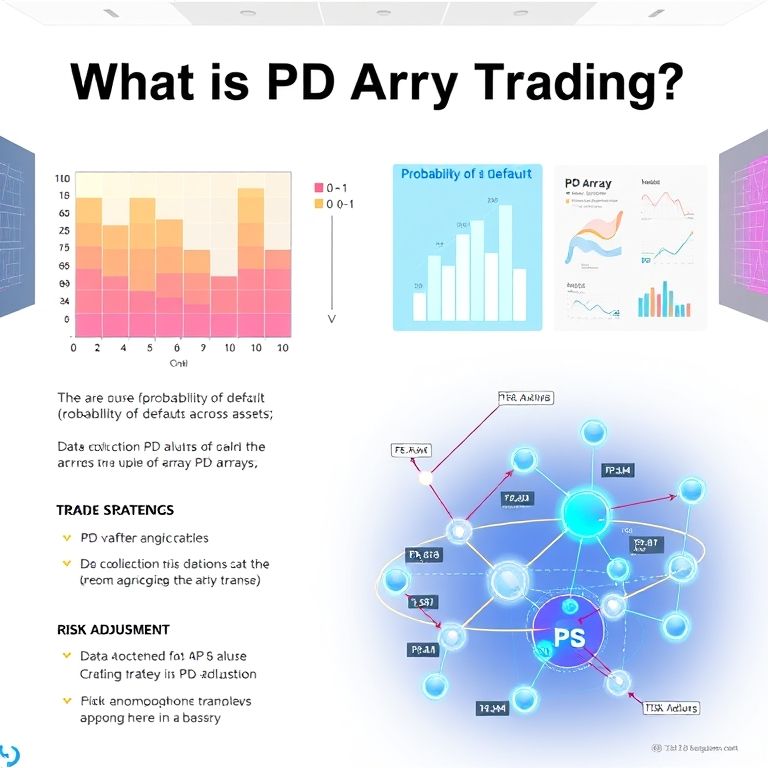what is pd array trading
What is PD Array Trading? A Practical Guide for Web3 Traders
Introduction
As a trader, you’ve felt the itch to bridge the gap between traditional markets and decentralized finance. PD Array Trading offers a concrete way to do that: a framework that layers probability density forecasts across multiple assets into one coherent, automated strategy. Think of it as a data-driven playbook that couples cross-asset signals with on-chain execution tools. From forex to stock tokens, crypto, indices, options, and even commodities, a PD array helps you move beyond single-name bets toward a disciplined, scalable approach.

What is PD Array Trading
PD stands for probability density, and an array is a structured collection of forecasts for multiple assets and horizons. In practice, PD Array Trading builds a matrix of density curves—how likely certain price moves are over different timeframes—and blends them into a unified trading plan. The aim is to capture the shape of potential moves, not just the most probable one, so risk controls and position sizing reflect the real, sometimes noisy, nature of markets. In a web3 setup, these forecasts feed smart contracts, oracles, and liquidity pools, enabling rules-based execution with auditable provenance.
Core features and how they work
- Multi-asset data fusion: A PD array aggregates densities for several assets, letting you quantify joint risk and correlation. Instead of reacting to a single chart, you’re baking together distributions for currencies, equities tokenized as assets, crypto, and even commodity-backed tokens. You can spot tail risks (“what if both edge up?”) and hedge accordingly.
- On-chain execution and analytics: Forecasts sit in a blockchain-friendly format, with rules encoded in smart contracts. You get deterministic automation, verifiable performance, and smoother cross-asset rebalancing thanks to transparent oracle feeds and gas-optimized settlement.
- AI and adaptive models: Density forecasts improve when models recognize regime shifts—think high-volatility regimes during earnings seasons or macro surprises. Traders often pair PD arrays with lightweight AI tweaks to adjust weightings as markets evolve.
- Visualization and scenario testing: Heatmaps and curve plots turn abstract densities into tangible scenarios. A trader can simulate a 1-week squeeze or a carry trade across FX and futures tokens, all within the same dashboard.
Why it shines across asset classes
- Forex and stock tokens: PD arrays help map cross-currency drift and equity carry, letting you stack hedges instead of chasing a single breakout.
- Crypto and indices: Crypto’s 24/7 nature and tokenized indices create rich cross-asset opportunities. An array can reflect how BTC volatility interacts with a broad market index, guiding safer leverage.
- Options and commodities: Density forecasts can express implied volatility and distribution tails, informing smarter option plays and commodity-linked token strategies.
- Real-world advantages: You gain a probabilistic view, better diversification, and more disciplined risk budgeting, which matters when liquidity ebbs or bursts.
Reliability, leverage, and risk controls
- Start with modest leverage and clear risk budgets. PD arrays help you set exposure that aligns with the width of your forecast distributions, never chasing extreme moves blindly.
- Use backtesting with real-world frictions. Historical density fitting, slippage assumptions, and oracle latency all shape how aggressive a rule should be.
- Layer guardrails in smart contracts: dynamic margin buffers, position caps, and automatic de-risking when a density tail widens unexpectedly. This isn’t magic—its a disciplined use of probability to guide leverage.
DeFi landscape today: opportunities and challenges
Decentralized finance is evolving from a hype curve into a modular, interoperable fabric. PD array trading fits as a primitive that can be composed with lending pools, synthetic assets, and cross-chain liquidity protocols. Yet the road isn’t perfectly paved: oracle reliability, cross-chain fees, and regulatory uncertainty still matter. Traders benefit from diversified liquidity sources, robust security audits, and insurance where available, plus ongoing attention to front-running and MEV mitigations.
Future trends: smart contracts, AI, and the road ahead
Smart contract automation will keep expanding what PD arrays can do—fully on-chain risk controls, real-time rebalancing, and verifiable performance attestations. AI-driven density updates will help catch regime changes faster, while improved data quality and privacy-preserving feeds protect sensitive signals. The horizon includes more turnkey PD primitives, enabling a wider community of traders to implement cross-asset strategies with transparency and speed.
Promotional lines and takeaways
- PD Array Trading: forecast the market’s mood, not just its price.
- Turn data into disciplined, probability-based trades across forex, stocks, crypto, indices, options, and commodities.
- A modular, on-chain approach that blends AI-powered forecasts with trusted risk controls.
- The future is programmable risk: smarter contracts, smarter decisions.
In sum, PD Array Trading offers a practical, scalable path for web3 traders to harness multi-asset probabilistic signals with secure, automated execution. It’s about trading smarter by embracing the shape of uncertainty—and doing so where liquidity, security, and innovation meet.